- Class is a logical entity that defines the data and behaviors of objects but does not use memory itself. An object is a physical instance of a class that is allocated memory.
- Constructors are special methods that initialize objects and are called when an object is created using the new keyword. They must have the same name as the class and do not have a return type.
- There are three types of constructors: the default constructor created by the compiler if none is defined, the no-argument constructor, and the parameterized constructor that accepts arguments.
- The this keyword refers to the current object instance and is used to differentiate class attributes from method parameters or to call another constructor of the same class.

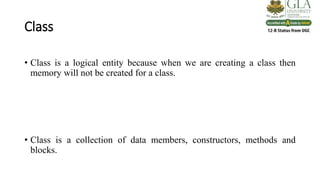
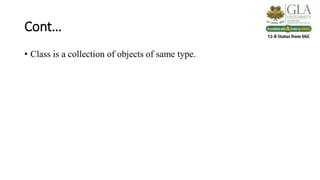
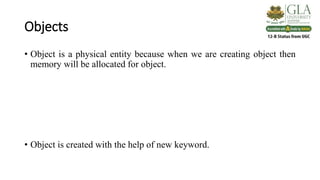

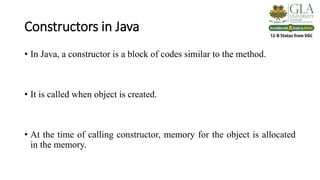





![Example
class Student
{
int id;
public static void main(String a[])
{
Student s1=new Student();
System.out.println(s1.id);
}
}
Output: 0](https://image.slidesharecdn.com/bcaclassandobject3-230821131834-f4478ba9/85/BCA-Class-and-Object-3-pptx-12-320.jpg)

![Example
class Bike
{
Bike()
{
System.out.println("Bike is created");
}
public static void main(String a[])
{
Bike b=new Bike();
}
}
Output: Bike is created](https://image.slidesharecdn.com/bcaclassandobject3-230821131834-f4478ba9/85/BCA-Class-and-Object-3-pptx-14-320.jpg)

![Example
class Student
{
int id;
String name;
Student(int i, String n)
{
id = i;
name = n;
}
void display()
{
System.out.println(id);
System.out.println(name);
}
public static void main(String a[])
{
Student s1 = new Student(111,"Karan");
s1.display();
}
}](https://image.slidesharecdn.com/bcaclassandobject3-230821131834-f4478ba9/85/BCA-Class-and-Object-3-pptx-16-320.jpg)
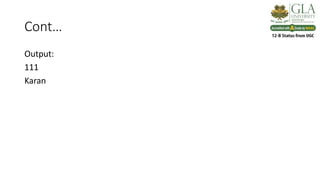



![Example
class Student
{
int id;
public static void main(String a[])
{
Student s1= new Student();
s1.id=101;
System.out.println(s1.id);
}
}
Output
101](https://image.slidesharecdn.com/bcaclassandobject3-230821131834-f4478ba9/85/BCA-Class-and-Object-3-pptx-21-320.jpg)
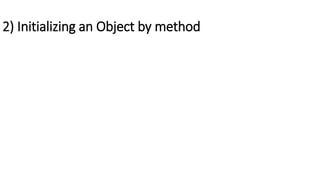
![Example
class Student
{
int id;
void display(int n)
{
id = n;
System.out.println(id);
}
public static void main(String a[])
{
Student s1=new Student();
s1.display(101);
}
}](https://image.slidesharecdn.com/bcaclassandobject3-230821131834-f4478ba9/85/BCA-Class-and-Object-3-pptx-23-320.jpg)


![Example
class Student
{
int id;
Student(int i)
{
id = i;
}
void display()
{
System.out.println(id);
}
public static void main(String a[])
{
Student s1 = new Student(101);
s1.display();
}
}](https://image.slidesharecdn.com/bcaclassandobject3-230821131834-f4478ba9/85/BCA-Class-and-Object-3-pptx-26-320.jpg)

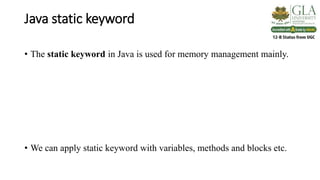

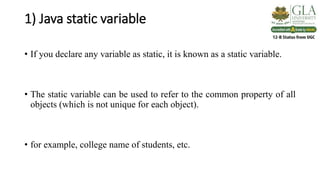
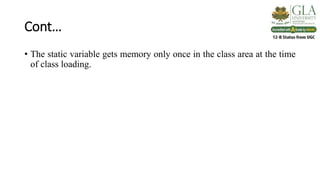

![Example: Understanding the problem without
static variable
class Student
{
String collegename;
Student(String c)
{
collegename = c;
}
void display ()
{
System.out.println(collegename);
}
public static void main(String a[])
{
Student s1 = new Student("GLAU");
Student s2 = new Student("GLAU");
s1.display();
s2.display();
}
}](https://image.slidesharecdn.com/bcaclassandobject3-230821131834-f4478ba9/85/BCA-Class-and-Object-3-pptx-33-320.jpg)

![Example of static variable
class Student
{
static String collegename =“GLAU";//static variable
void display ()
{
System.out.println(collegename);
}
public static void main(String a[])
{
Student s1 = new Student();
Student s2 = new Student();
s1.display();
s2.display();
}
}](https://image.slidesharecdn.com/bcaclassandobject3-230821131834-f4478ba9/85/BCA-Class-and-Object-3-pptx-35-320.jpg)


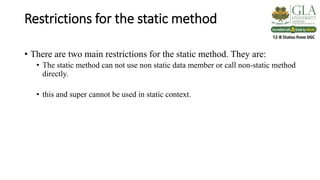
![Example of static method
class A
{
static void display()
{
System.out.println("Static Method");
}
}
class B
{
public static void main(String a[])
{
A.display();
}
}](https://image.slidesharecdn.com/bcaclassandobject3-230821131834-f4478ba9/85/BCA-Class-and-Object-3-pptx-39-320.jpg)


![Example of static block
class A
{
static
{
System.out.println("static block");
}
public static void main(String a[])
{
System.out.println("Hello main");
}
}](https://image.slidesharecdn.com/bcaclassandobject3-230821131834-f4478ba9/85/BCA-Class-and-Object-3-pptx-42-320.jpg)

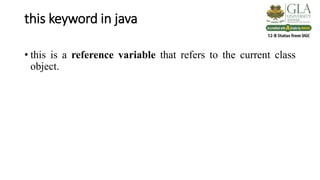


![Example: Problem without this keyword
class Student
{
int x;
int y;
Student(int x, int y)
{
x = x;
y = y;
}
void display()
{
System.out.println(x);
System.out.println(y);
}
public static void main(String a[])
{
Student s1=new Student(10,20);
s1.display();
}
}](https://image.slidesharecdn.com/bcaclassandobject3-230821131834-f4478ba9/85/BCA-Class-and-Object-3-pptx-47-320.jpg)

![Ex: Solution of Previous Problem with this keyword
class Student
{
int x;
int y;
Student(int x, int y)
{
this.x = x;
this.y = y;
}
void display()
{
System.out.println(x);
System.out.println(y);
}
public static void main(String a[])
{
Student s1=new Student(10,20);
s1.display();
}
}](https://image.slidesharecdn.com/bcaclassandobject3-230821131834-f4478ba9/85/BCA-Class-and-Object-3-pptx-49-320.jpg)


![Example 1
class A
{
A()
{
System.out.println("hello a");
}
A(int x)
{
this();
System.out.println(x);
}
public static void main(String a1[])
{
A a=new A(10);
}
}](https://image.slidesharecdn.com/bcaclassandobject3-230821131834-f4478ba9/85/BCA-Class-and-Object-3-pptx-52-320.jpg)
